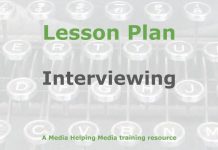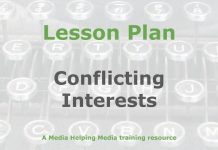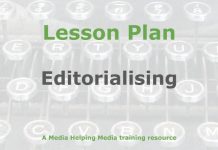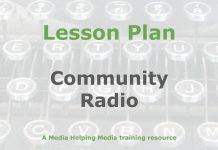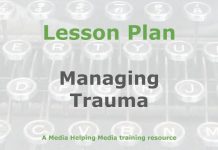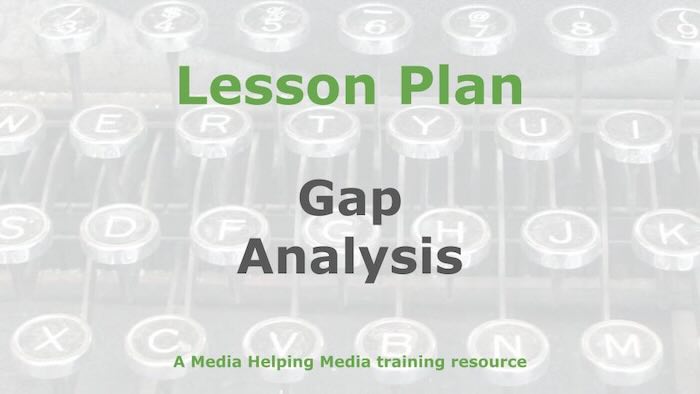 This lesson plan is designed to help participants understand the importance of carrying out ‘gap analysis when designing a training of trainers (ToT) course.
This lesson plan is designed to help participants understand the importance of carrying out ‘gap analysis when designing a training of trainers (ToT) course.
It’s based on the article Gap analysis for media training, which we recommend trainers read before adapting this lesson plan for your own purposes.
Learning objective
Students will evaluate the importance of gap analysis in designing a training of trainers (ToT) course for journalism. They will identify specific gaps between current and desired competencies of potential trainers to enhance training effectiveness.
- Student-facing objective: By the end of this lesson participants will understand why gap analysis is crucial for creating effective journalism training courses and how to spot the skills trainers need to improve.
- Standards: A trainer will learn the importance of carrying out gap analysis when designing a training of trainers (ToT) course.
Learning activities
Warm-up
Display a simple scenario: “A media company wants to improve its training programme for new journalists. They currently focus on print media but want to expand to digital platforms.” Ask students: “What skills might be missing in their current training?” Ask participants to think about the issue and jot down ideas. Then, have them share with a partner. Finally, ask a few students to share their thoughts with the class. Record key skills mentioned, such as digital literacy or social media proficiency, to set the stage for discussing gap analysis.
Direct instruction
- Introduce gap analysis: Begin with a brief explanation of gap analysis. Define it as a method to identify the difference between current and desired competencies. Use the media company scenario from the warm-up to illustrate how gap analysis can pinpoint missing skills, such as digital literacy.
- Identify current competencies: Explain how to assess current skills. Discuss methods such as surveys, interviews, and skills assessments. Use a real-world example: A media company evaluates its trainers’ proficiency in digital journalism tools. Describe how to conduct a skills assessment and what to look for.
- Define desired competencies and analyse gaps: Discuss how to determine the skills needed for effective training. Highlight industry best practices and audience needs. Use the media company example to show how to identify gaps, such as the need for social media verification skills. Explain how to prioritise these gaps and develop targeted training interventions.
Guided practice
Think, Pair, Share: Guide students through a structured discussion to deepen understanding of gap analysis.
- Think: Ask students to individually consider a scenario where a journalism ToT course lacks proficiency in data journalism. Have them think about how gap analysis could identify this need and suggest potential training interventions.
- Pair: Instruct students to pair up and discuss their thoughts. Encourage them to compare their ideas on identifying gaps and proposing solutions.
- Share: Facilitate a class discussion where pairs share their insights. Record key points on the board, focusing on how gap analysis can lead to targeted training improvements. Use this as an opportunity to clarify any misconceptions.
- Connect: Highlight connections between students’ ideas and the broader importance of gap analysis in journalism training. Emphasise how addressing specific gaps enhances training effectiveness.
- Reflect: Conclude with a brief reflection. Ask students to write down one new understanding they gained about gap analysis and its application in media training. Collect these reflections to assess comprehension.
Independent practice
- Exercise: Provide students with a case study of a journalism ToT course. Ask them to conduct a gap analysis by identifying current and desired competencies. Have them list the gaps and propose targeted training interventions.
- Observation: Circulate the room to observe students’ progress. Offer guidance and feedback as needed to ensure understanding and correct application of gap analysis principles.
Assignment
Ask students these questions:
- What is one key benefit of using gap analysis in journalism training?
- How can identifying gaps between current and desired competencies improve a ToT course?
- What’s one question you still have from today’s lesson?
Suggested answers:
- Suggested answer to Question 1: Gap analysis ensures training is relevant and impactful by focusing on specific needs.
- Suggested answer to Question 2: It allows for targeted training interventions that address specific skill deficiencies.
Teacher resources
Differentiation guide
- Advanced learners: Encourage them to explore additional case studies or real-world examples of gap analysis in media training. Challenge them to identify potential gaps and propose innovative solutions. Allow them to present their findings to the class for peer feedback.
- Striving learners: Provide additional scaffolding by breaking down the gap analysis process into smaller, manageable steps. Use visual aids, such as flowcharts to illustrate the process. Pair them with peers for collaborative exercises to build confidence and understanding.
- Recommended reading: This lesson plan is based on the article Gap analysis for media training, which we recommend trainers read before adapting this lesson plan for your own purposes.
Notable definitions
- Gap analysis: A method to identify the difference between current and desired competencies, particularly in training contexts, to pinpoint areas needing improvement.
- Competencies: The skills and knowledge required to perform a specific task effectively, often used to assess training needs.
- Training of trainers (ToT): A programme designed to equip trainers with the necessary skills and knowledge to effectively deliver training to others, often involving a focus on adult learning principles and modern training techniques.
Required materials
- Computers: For accessing the case study and conducting research.
- Projector: To display scenarios and important points during discussions.
- Whiteboard and markers: For recording student insights and the main concepts.
- Printed case studies: For students to analyse during independent practice.
- Notebooks and pens: For students to jot down ideas and reflections.
Lesson summary
- Warm-up
- Direct instruction
- Guided practice
- Independent practice
- Assignment
The free teaching tools at the Khan Academy were used in the production of this lesson plan.
